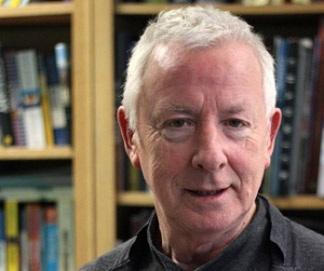Published 08/04/2013
One of publishing's most lovable eccentrics died of cancer on 3 February. A true friend to many editors, designers, authors as well as colleagues at the Bridgeman Art Library

|
Harriet Bridgeman remembers... "Tom Graves used the Bridgeman Art Library for many years in his capacity as a picture researcher and he subsequently worked for the Library archiving a number of collections. He was much loved and his sudden death from cancer came as a great shock to us all. Together with Sheila Corr, the picture editor of History Today, we organised a memorial service at his much loved Ealing Abbey attended by about two hundred of his friends from the publishing world, at which David Roberts gave the following address..." |
Tom Graves - eccentric, outspoken, entertaining
David Roberts 15 February 2013
David Roberts recalls, with a smile, the picture researcher Tom Graves.
It is hard not to smile when one thinks of the picture researcher Tom Graves - one of publishing's most lovable eccentrics, who died of cancer on 3 February. He was a true friend to many editors, designers and authors, among them Lord Longford and Steven Runciman. Proud of his Irishness - he was born in Waterford in 1941 (his father, he said, was a colleague of Eamon de Valera) - he nevertheless lived most of his life in London. He worked for many publishers of illustrated books including Hamlyn, Rainbird, and Weidenfeld & Nicolson, as well as for magazines such as History Today. He was highly regarded for his professionalism and knowledge of all the great picture archives, and counted as friends many famous archivists, notably John Kobal and his close friend and mentor Harriet Bridgeman.
Pugnacious, indignant and outspoken when he came across impatient officialdom, Tom was fired on several occasions but took no notice, continuing with his work without comment. He treated junior employees and the exalted with the same easy familiarity, refusing to be snubbed or browbeaten, and most if not all his employers enjoyed his discourse. In the late Sixties and early Seventies he became a friend of Paul Hamlyn, who retained an office in the building where the company he no longer owned was based. Later in his career, as a freelance but virtual employee of Weidenfeld, he would buttonhole Lord Weidenfeld in the lift and lecture him on how to run his company, without giving offence.
Proud of being gay and of his fine profile, to which he would draw your attention at the slightest encouragement, he did not approve of campaigning or joining marches. He loyally nursed many friends during the Aids crisis but remained healthy himself. He had a treasury of stories, many of doubtful authenticity but none the less amusing for that. He could find just the right picture and, importantly, obtain permission to use it at a good price. He enjoyed his errors, which were few but recalled with glee, notably that of introducing into Peter Ustinov's history of Russia a photograph of Crown Prince Rudolf of Austria after his suicide at Mayerling with a caption identifying the corpse as Stalin on his deathbed.
His tiny flat in Ealing was comfortably close to the Abbey, to which he attached himself, enjoying nothing more than working in the gardens. In Bloomsbury and beyond he was a familiar figure in his bobble hat and with a bag of books slung over his shoulder. He loved London, and knew more about its buildings than many natives.
Tom's loss will be felt keenly by his many friends, whom he would entertain by quoting reams of verse, notably Shakespeare, and stories of a life lived to the full.
Trevor Dolby adds:
I recall Tom Graves with such affection.
I worked with Tom at Orion, and he was one of those rare and precious people who lit up a room and made gossip sparkle. He was conspiratorial but never malicious, funny and witty but never at another's expense. Encounters always left me smiling. He seemed have boundless enthusiasm and radiated a love of life. He was also a stonking good picture researcher.
When he learned of my affection for musical theatre he insisted we spend each Wednesday afternoon around 3pm singing songs from the shows in my office. He would appear on the dot. If I was on the phone he'd tap his wrist and fold his arms impatiently. I made my apologies and in a twinkling he was off into "Trouble" or "Damn, damn, damn, damn..." or "Oh what a beautiful morning", and I would join in, at least for the first few lines, while Tom sang the song from start to finish in a light tenor.
When I left Orion he presented me with a full set of original foyer cards for Seven Brides for Seven Brothers, and announced that he had no doubt at I was a heterosexual gay.
The world is diminished for not now having Tom in it. "Bless his beautiful hide!"
http://www.bookbrunch.co.uk/article_free.asp?pid=tom_graves_eccentric_outspoken_entertaining


